Workbook Answer Key
Welcome, pages 2- -3
A. Unscramble.
Students look at the pictures, unscramble the words, and
then write sentences.
Answers
1. I always make my bed in the morning.
2. We' re shopping at the department store.
3. I'm walking to my cousin's home.
4. My uncle and I are making a cake.
B. What about you? Write.
Students answer the questions, writing sentences about
themselves.
C. Circle.
Students read the sentences and circle the correct
answers.
Answers
1. False
2. True
3. False
4. True
5. True
6. False
D. Match.
Students write the letter of the picture that matches the
word or phrase.
Answers
1.d
2. c
3.b
4. a
Unit 1, Fun Outdoors
Lesson 1, Camping, pages 4-5
A. Match.
Students write the letter of the picture that matches the
word or phrase. .
Answers
1.f
2. c
3. e
4. a
5.b
6. d
B. Write.
Students write the words, using the key. .
Answers
1. hiking
2. climbing
3. fishing
4. canoeing
5. watching birds
6. grilling hamburgers
C. Write.
Students look at the picture and complete or write the
questions and answers.
Answers
1. What does he like doing? He likes grilling
hamburgers.
2. What does she like doing? She likes watching birds.
3. What does she like doing? She likes climbing.
4. What does he like doing? He likes fishing.
D. Write and circle.
Students look at the pictures, write the questions, and
then circle the correct answers.
Answers
1. Does he like canoeing?
Yes, he likes it a lot.
2. Does she like grilling hamburgers?
No, she doesn't like it at all.
3. Does he like hiking?
No, he doesn't like it at all.
4. Does she like watching birds?
Yes, she likes it a lot.
Lesson 2, Sports, pages 6-7
A. Write.
Students look at the pictures and write the words.
Answers
1. snowboard
2. ski
3. ice-skate
4. skateboard
5. surf
6. in-line skate
B. Read and number.
Students read the sentences and number the pictures.
Answers
1. d
2. c
3. e
4. a
5. f
6. b
C. Write.
Students look at the pictures and write the sentences.
Answers
1. Is he good at ice-skating?
Yes, he's very good at it.
2. Is he very good at sking?
No, he's not very good at it.
3. Is she good at surfing?
Yes, she's very good at it.
4. Is she good at skateboarding?
No, she's not very good at it.
5. Is he good at snowboarding?
Yes, he's very good at it.
6. Is he good at in-line skating?
No. he's not very good at it.
D. Unscramble.
Students look at the pictures, unscramble the words, and
then write the sentences.
Answers
1. Is he good at in-line skating?
No, he's not very good at it.
2. Is she good at skiing?
Yes, she's very good at it.
Lesson 3, Reading, pages 8-9
A. Read and number.
Students read and then number the sentences in the
correct order.
Answers
1. I'm not very good at skiing.
2. Don't worry. I can help you.
3. See, you can do it!
4. Yes, I can!
B. Match.
Students write the letter of the picture that matches the
word or phrase.
Answers
1. c
2. b
3. d
4. a
C. Write and match.
Students complete the sentences, draw lines matching the
sentences to the pictures, and then write the sentences.
Answers
1. I'm not very good at in-line skating. d,
Don't worry. I can help you. .
2. I'm not very good at skateboarding. e,
Don't worry. I can help you.
3. I'm not very good at ice skating. f,
Don't worry. I can help you.
4. 'm not very good at skiing. C,
Don't worry. I can help you.
5. I'm not very good at surfing. b,
Don't worry. I can help you.
6 I'm not very good at snowboarding. a,
Don't worry. I can help you.
D. What about you? Write.
Students answer the questions, writing sentences about
themselves.
Lesson 4, Safety, pages 10-11
A. Unscramble.
Students unscramble the letters and write the answers.
Answers
1. wear a helmet
2. wear a life jacket
3. put on sunscreen
4. fasten your seatbelt
B. Connect.
Students draw lines, connecting the two halves of the
sentences with the pictures.
Answers
1. When you go snowboarding, always wear a helmet. d
2. When you go to the beach, always put on sunscreen. b
3. When you go canoeing, always wear a life jacket. c
4. When you ride in a car, always fasten your seatbelt. a
C. Look at the chart. Write.
Students complete or write the sentences, using the chart.
Answers
1. When you ride in a car, always fasten your seatbelt.
2. When you go in-line skating, always wear a helmet.
3. When you go canoeing, always wear a life jacket.
4. When you go skiing, always put on sunscreen.
D. Draw and write.
Students complete the sentence, writing about themselves,
and then draw a picture.
Unit2, Land and Sea
Lesson 1, Animals and Insects,
pages 12-13
A. Do the puzzle.
Students find and circle the words in the word search.
Answers
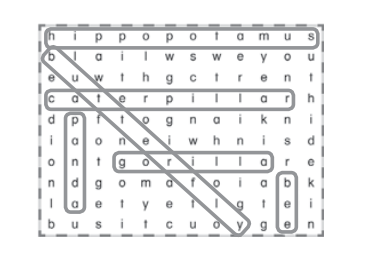
B. Write.
Students look at the pictures and write the words.
Answers
1. bee,
2. caterpillar
3. butterfly
4. panda
5. gorilla
6. hippopotamus
C. Circle.
Students look at the pictures and circle the correct words,
completing the sentences.
Answers
1. The gorilla is smaller than the hippopotamus.
The hippopotamus is the biggest.
2. The caterpillar is bigger than the bee.
The bee is the smallest.
3. The dog is smaller than the cow.
The cow is the biggest.
D. Write.
Students look at the pictures and complete or write the
sentences.
Answers
Which one is the smallest?
The duck is the smallest?
Which one is the biggest?
The horse is the biggest.
Lesson 2, Sea Creatures, pages 14-15
A. Unscramble.
Students unscramble the letters and write the words.
Answers
1. dolphin
2. whale .
3. squid
4. seal
5. eel
6. shark
B. Circle.
Students circle the correct words, completing the
sentences.
Answers
1. The dolphin isn't as long as the whale.
2. The shark isn't as long as the whale.
3. The dolphin is as long as the seal.
4. The seal isn't as long as the shark.
5. The squid isn't as long as the dolphin.
6. The eel is as long as the squid.
C. Write.
Students look at the pictures and complete or write the
sentences.
Answers
1. Is the squid as long as the shark?
No, it isn't. It's shorter.
2. Is the seal as long as the dolphin?
Yes, it is.
3. Is the fish as big as the whale?
No, it isn't. It's smaller.
4. Is the spider as big as the ant?
Yes, it is.
5. Is the turtle as fast as the lion?
No, it isn't. I's slower.
6. Is the dog as fast as the rabbit?
Yes, it is.
Lesson 3, Reading, pages 16- 17
A. Read and number.
Students read and then number the sentences in the
correct order.
Answers
1. Wait! What about Mom?
2. Which one would she like?
3. Do you like it, Mom?
4. Thanks, girls! This is the best hat!
B. Match.
Students write the letter of the picture that matches the
word or phrase.
Answers
1.d
2. e
3. C
4. b
5. a
C. Match.
Students write the letter of the picture that matches the
word or phrase.
Answers
1. c
2. a
3.b
4. d
D. Unscramble.
Students unscramble the words and write the sentences.
1. Which one would you like?
Id like the fastest one, please.
2. Which ones would you like?
We'd like the longest ones, please.
E. What about you? Write.
Students answer the questions, writing sentences about
themselves.
Lesson 4, Weight and Length,
pages 18-19
A. Match.
Students write the letter of the picture that matches the
word or phrase.
Answers
1.d
2. c
3.b
4. a
B. Look at the chart. Write.
Students complete or write the sentences, using the chart.
Answers
1. How much does the Komodo dragon weigh?
It weighs 150 kilograms.
2. How long is the giant Pacific octopus?
It's 5 meters long.
3. How much does the spider crab weigh?
It weighs 19 kilograms.
4. How long is the Goliath beetle?
It's 10 centimeters long.
C. Write.
Students complete or write the sentences.
Answers
1. The squid is 60 centimeters long.
2. The seal is 2 meters long.
3. The hippopotamus weighs 3,000 kilograms.
4. The blue whale weighs 120,000 kilograms.
D. Look at C . Circle.
Students look at exercise C and circle the correct answers.
Answers
1. False
2. False
3. False
4. True .
Check Up 1, pages 20 -22
A. Match.
Students write the letter of the picture that matches the
word or phrase.
Answers
1. c
2. e
3. a
4.b
5. f
6. d
B. Read, write, and number.
Students read and complete the sentences, then number
the pictures.
Answers
1. Does she like grilling hamburgers?
No, she doesn't like it at all [4th picture]
2. When you go to the beach, always put on sunscreen.
[1st picture]
3. The fish isn't as big as the whale. [3rd picture]
4. The hippopotamus is bigger than the gorilla.
[2nd picture]
C. Read, circle, and write.
Students look at the pictures, circle the correct answer,
and write sentences.
Answers
1. [the smallest], The duck is the smallest.
2. [long], The seal is 2 meters long.
3. [doing], She likes canoeing.
4. [in-line skating], No, he isn't very good at it.
D. Look at the pictures. Write.
Students look at the pictures and write to complete the
dialogue.
Answers
1. I'm not very good at playing soccer.
Don't worry. I can help you.
2. Which one would you like?
I'd like the smallest one, please.
E. What are you very good at? Write.
Students answer the question, writing a sentence about
themselves.
F. Do the puzzle.
Students use the key to fill in the crossword puzzle.
Answers
Animals and Insects
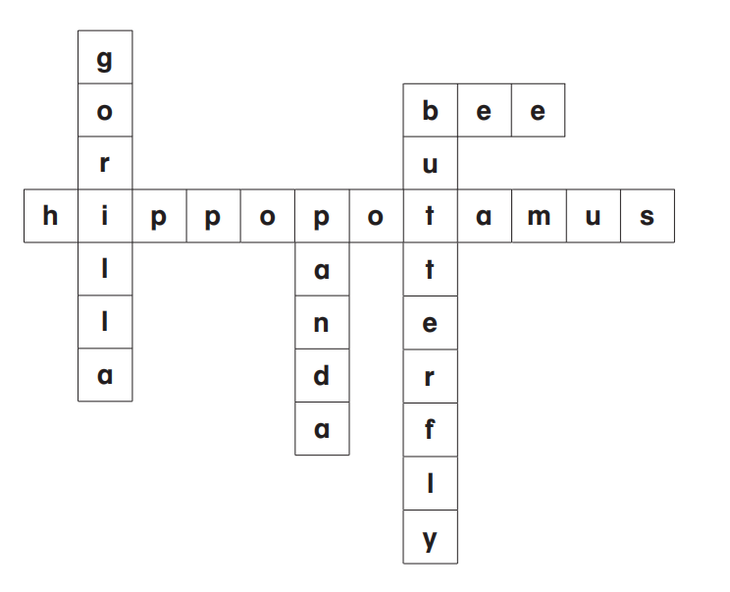
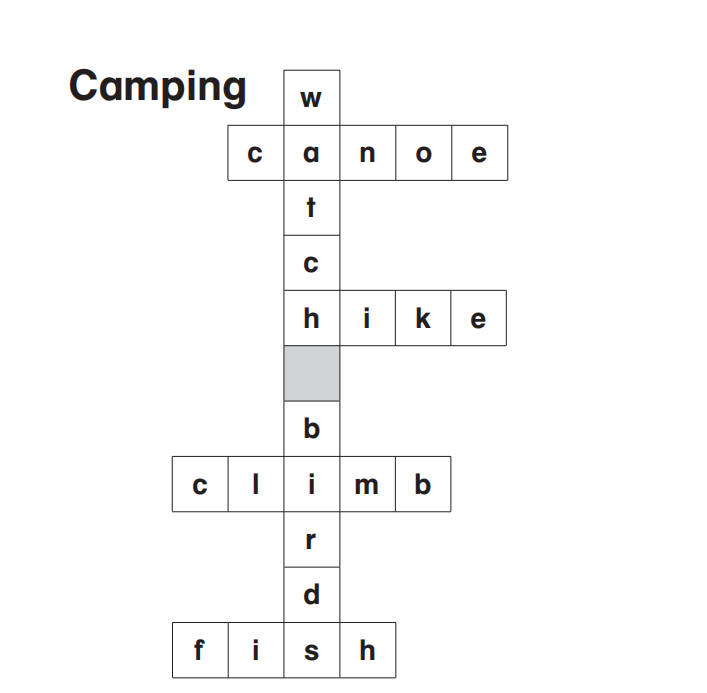
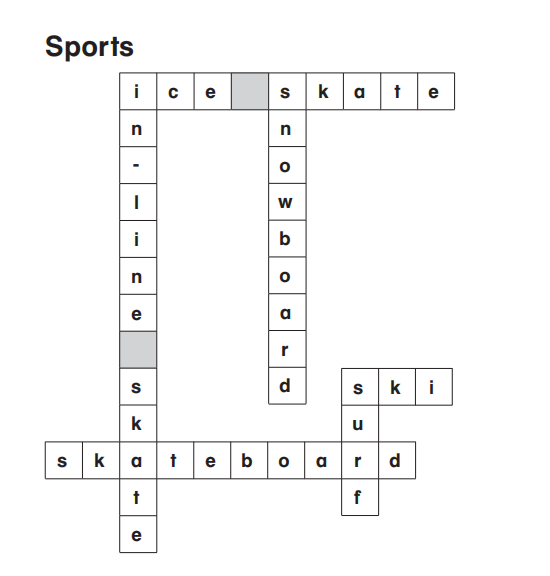
Skills 1, page 23
A. Read and circle.
Students read the passage and circle the correct answers.
Answers
1. False
2. True :
3. False
4. True
B. What about you? Look at A . Write.
Students look at exercise A as an example and complete the
sentences, writing about themselves.
Unit 3, Appearance
Lesson 1, What We Look Like,
pages 24- 25
A. Match.
Students write the letter of the picture that matches the
word or phrase.
Answers
1. e
2. a
3. f
4.g
5. h
6. b
7. d
8. C
B. Unscramble.
Students unscramble the letters and write the words.
Answers
1. black hair
2. brown hair
3. red hair
4. gray hair
5. blond hair
6. brown eyes
7. green eyes
8. blue eyes
C. Write and match.
Students write the questions and then draw lines,
matching the questions to the answers.
Answers,
1. What does she look like? She has shoulder-length,
wavy hair.
2. What does she look like? She has long, straight hair.
3. What does he look like? He has short, curly hair.
4. What does he look like? He has a beard and glasses.
D. Write.
Students look at the picture and complete the sentences.
Answers
1. Which one is your sister?
She's the one with straight hair and glasses.
2. Which one is your father?
He's the one with short, curly hair.
3. Which one is your brother?
He's the one with short, wavy hair.
4. Which one is your mother?
She's the one with long, wavy hair.
Lesson 2, Accessories, pages 26- -27
A. Do the puzzle.
Students look at the pictures and write the words in the .
crossword puzzle.
Answers
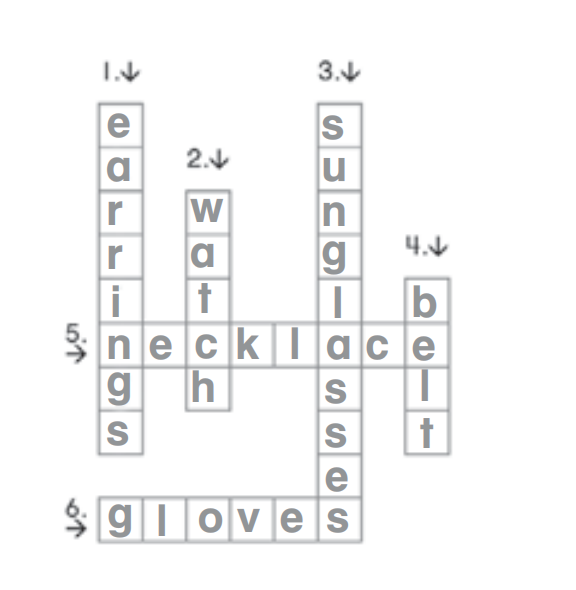
B. Unscramble.
Students unscramble the words and write the questions
and answers.
Answers
1. What does the watch look like?
It's new and black
2. What does the belt look like?
It's old and long.
3. What do the gloves look like?
They're big and gray
C. Write.
Students look at the picture and write the questions and
answers.
Answers
1. Which necklace does she want to wear?
She wants to wear the big one.
2. Which belt does he want to wear?
He wants to wear the short one.
3. Which gloves does he want to wear?
He wants to wear the white ones.
4. Which sunglasses does he want to wear?
He wants to wear the big ones.
5. Which watch does he want to wear?
He wants to wear the black one.
6. Which earrings does she want to wear?
She wants to wear the long ones.
Lesson 3, Reading, pages 28-29
A. Read and number.
Students read and then number the sentences in the
correct order.
Answers
1. Good luck on the test!
2. Thanks, Dad.
3. My pencils! What can I do now?
4. Don't worry. You can share mine.
B. Connect.
Students draw lines, connecting the sentences and the
pictures.
Answers
1. Good luck in the play. Thanks, Mom. b
2. Which one is Sam? He's the one wearing the black cap. d
3. Who's that wearing the white cap? That's Sam's brother. c
4. My water! What can I do now? Don't worry. You can share mine. a
C. Write.
Students complete the sentences using the key.
Answers
1. Good luck on the test.
2. Good luck with the play.
3. Good luck in the game.
D. What about you? Write.
Students answer the questions, writing sentences about
themselves. Answer will vary.
Lesson 4, Camouflage, pages 30-31
A. Write.
Students look at the pictures and write the words.
Answers
1. tree
2. leaf
3. grass
4. stick
5. river
6. fish
7. rock
8. sand
B. Unscramble.
Students unscramble the words and write the sentences.
Answers
1. The butterfly is the same shape as the leaf.
2. The fish is the same color as the sand.
3. The snake is the same color as the grass.
4. The caterpillar is the same shape as the stick.
C. Write.
Students look at the pictures and write the questions and
answers.
Answers
1. What does the turtle look like?
It's the same color and shape as the rock
2. What does the frog look like?
It's the same color as the leaf.
3. What does the crab look like?
It's the same color as the sand.
D. Read and draw.
Students draw pictures, illustrating the sentences.
Unit 4, Last Week
Lesson 1, Sports, pages 32-33
A. Do the puzzle.
Students find and circle the words in the word search.
Answers

B. Write.
Students look at the pictures and write the words.
Answers
1. tennis
2. baseball
3. basketball
4. table tennis
5. yolleyball
6. golf
C. Write.
Students look at the pictures and write the sentences.
Answers
1. He played golf yesterday.
2. She played basketball yesterday.
3. He played baseball yesterday.
4. She played tennis yesterday.
5. He played table tennis yesterday.
6. She played volleyball yesterday.
D. Circle.
Students look at the pictures and circle the correct words,
completing the sentences.
Answers
1. What did she do yesterday?
She played tennis yesterday.
2. What did they do yesterday.
They played volleyball yesterday.
Lesson 2, Activities, pages 34- - 35
A. Connect and write.
Students draw lines, connecting the words, and then write
the phrases.
Answers
1. d, talk on the phone
2. e, practice the piano
3. b, visit my friend
4. C, work on a project
5. f, help my parents
6. a, use the computer
B. Write.
Students complete or write the questions and answers.
Answers
1. What did you do last weekend?
I worked on a project.
2. What did you do last weekend?
I talked on the phone.
3. What did you do last weekend?
I used the computer.
4. What did you do last weekend?
I visited my friend.
C. Write.
Students look at the pictures and complete the questions
and answers.
Answers
1. Did you visit your friend on Monday?
Yes, I did.
2. What did you do on Friday?
I used the computer on Friday.
3. Did you practice the piano on Sunday?
No, I didn't practice the piano on Sunday.
4. What did you do on Sunday?
I talked on the phone on Sunday.
D. What about you? Write.
Students answer the questions, writing sentences about themselves.
Lesson 3, Reading, pages 36- -37
A. Read and number.
Students read and then number the sentences in the
correct order.
Answers
1. Come on! Hurry up!
2. What's wrong?
3. I can't find my coat.
4. Don't worry. You can borrow mine.
B. Connect and write.
Students draw lines, matching the words, and then write
the phrases. .
Answers
1. d, Don't worry.
2. a, What's wrong?
3. b, I can't find my glove.
4. e, Come on!
5. C, Hurry up!
C. Write and match.
Students complete the sentences, using the key. .
Answers
1. I can't find my ruler. e .
2. I can't find my stapler. d
3. I can't find my dictionary. f
4. I can't find my paintbrush. b
5. I can't find my calculator. a
6. I can't find my glue. c
D. What about you? Write.
Students answer the questions, writing sentences about
themselves.
Lesson 4, Ancient Rome, pages 38- -39
A. Write.
Students write the words in the picture, using the key.
Answers
a. homes
b. stone
C. clay
d. bowls
e. metal
f. neckaces
g. glass
h. cups
B. Look at A . Write.
Students look at exercise A and complete or write the
questions and answers.
Answers
1. What did they use to make bowls?
They used clay.
2. What did they use to make cups?
They used glass.
3. What did they use to make necklaces?
They used metal.
4. What did they use to make homes?
They used stone.
C. Read and fill in the chart.
Students read the sentences and then fill in the chart.
Answers

D. What did you use? Write.
Students answer the questions, writing sentences about
themselves.
Check Up 2, pages 40- -42
A. Unscramble and check.
Students look at the pictures and unscramble the words,
then check the relevant words.
Answers
1,√ curly wavy starlight
2. grass √ leaf stick
3. Visit help √ practice
4. √ glass stone metal
5. Baseball √ volleyball tennis
6. Necklace belt √ watch
B. Read, circle, and match.
Students read the sentences, circle the correct word or
phrase, and match the sentences with the pictures.
Answers
1. He talked on the phone on Sunday. c
2. The fish is the same color as the sand. d .
3. They used metal to make necklaces in Rome. a
4. She has shoulder- length, straight hair. b
C. Look at the pictures. Unscramble the questions.
Students look at the pictures and unscramble the words.
Answers
1. What did she do last weekend?
2. What does he look like?
3. What did he do yesterday?
4. What did they use to make bowls in Rome?
D. Look at the pictures. Write.
Students look at the pictures and write to complete the
dialogue. .
Answers
1. Good luck in the game.
Thanks. You, too.
2. I can't find my glove.
Don't worry. You can borrow mine.
E. What did you do on Sunday? Write.
Students answer the question, writing a sentence about
themselves.
F. Look and write.
Students look at the picture and write the missing word.
Answers
1. grass
2. help my parents
3. straight hair
4. table tennis
5. basketball
6. work on a project
G. Look at F . Solve the puzzle.
Students use the answers in exercise F to find the missing
words.
Answers
Hi! My name is Ethan. I have short, curly hair and
brown eyes. I love sports. Last weekend, I played
tennis and baseball. It was great!
Skills 2, page 43
A. Read and circle.
Students read the passage and circle the correct answers.
Answers
1. True
2. False
3. False
4. True
B. What about you? Write.
Students answer the questions, writing sentences about
themselves.
